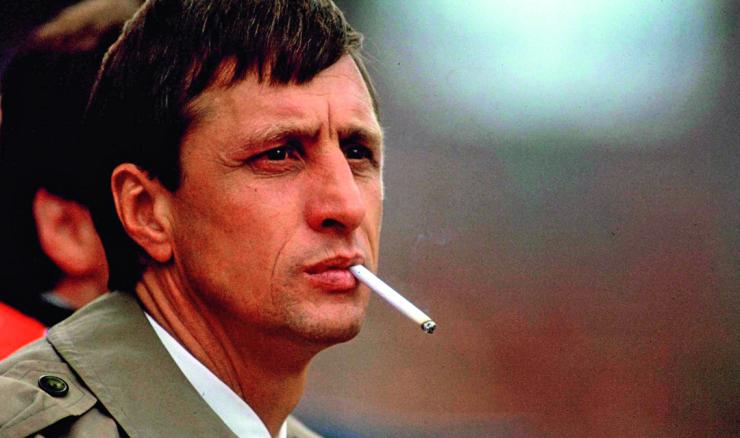
When everybody is competing to be noticed in the jumble of the social media age, obituaries can often be ostentatious affairs designed to exaggerate in the search for maximum impact. However there are not many more deserving of all the tributes attributed to him than Johan Cruyff who on Thursday sadly passed away at the age of 68.
The word legend, for instance, has lost some of its value over the years due to its overuse but with Cruyff it is thoroughly warranted. To say the Dutchman was a pioneer of the game who reinvented it, between the late 60s to the early 80s, is no hyperbole.
Winner of FIFA’S Balon D’Or in 1971, ’73 and ’74, Cruyff belongs in the company of Pele, Diego Maradona and Franz Beckenbaur when it comes to documenting the best ever.
The stalwart of Total Football
He was the stalwart of Rinus Michels’ “total football” that led Ajax to European dominance in the early 70s and had the Dutch mesmerise the globe on their way to the final of the World Cup of 1974.
“Without Cruyff I have no team” his mentor Michels, who took Cruyff to Barcelona with him in 1973, famously said and in the era when the Netherlands were blessed with Johnny Rep, Johan Neeskens and Ruud Krol, it was high praise indeed. Cruyff was Michels’ on-pitch orchestrator, arms pointing everywhere like a conductor of the grand display.
A centre-forward only on paper, the maestro refused to be restricted by established positional boundaries, often dropping deep to launch moves by taking it off his goalkeeper, then dictating the pace and direction of the play as his team gradually moved forward.
“He was at the heart of a revolution with his football,” said Eric Cantona. “If he wanted, he could be the best player in any position on the pitch.”
Take the very first minute of the 1974 final, Cruyff receives the ball in the open refuge of the centre-circle as Germany tentatively adjust to the game and witness him drag a defender out before driving into the heart of the opposition’s camp.
He would win the penalty that Neeskens converted thanks to a reckless lunge from Uli Hoeness before any German could touch the ball. It was typical of Cruyff, not simply playing to expectations or accepting norms.
Brilliant and capable of the outrageous
He was capable of the stunning athleticism that allowed him to convert the wonderful volleyed goal against Atletico Madrid for Barcelona in 1973 and the outrageous first touch to spin away from a hapless Den Haag defender a year earlier in 1972 in the build-up to a sumptuous curling effort over the goalkeeper.
It was his brilliant technique that allowed him to delicately trap a lofted through-ball against Argentina in the second round of the ’74 World Cup before utilising his fine balance and composure to round the goalkeeper and find the vacant net. There was also the audacious pass-penalty for Ajax against Helmond Sport that pushed back accepted levels of sportsmanship. That move could have easily gone wrong but you get the feeling Cruyff simply couldn’t avoid the temptation to try it.
He made it all look so easy when it was anything but; the simple act of dragging the ball behind the legs in a 180 degree turn now so widely-used but Cruyff conjured it against Swedish defender Jan Olsson over four decades ago.
“Playing football is very simple, but playing simple football is the hardest thing there is” he said and looking back it is easy to say Cruyff played it simply, moving into space, passing, retrieving and passing it on again, constantly breezing around the pitch into pockets of space.
Yet those ideas were revolutionary back then, captivating and usurping those who had become accustomed to playing with direct speed and physical strength.
Laying the foundations of a super club
Cruyff remained chained to the belief that football was primarily played with the head and it set the groundwork on which Michels built his 1988 European Championship winning side with Frank Rijkaard, Ruud Gullit and Marco Van Basten. The Dutchman took control of Barcelona as manager in the same year and laid the foundations of the super club that has dominated European football for the past decade.
The “Dream Team” that sauntered to four consecutive La Liga titles between 1991 and 1994 and landed the European Cup in 1992 was forged with the likes of Romario, Hristo Stoichkov, Michael Laudrup and Ronald Koeman, while Pep Guardiola was converted from a winger to the cultured centre-midfielder he appeared like he was born to play.
But most importantly Cruyff was instrumental in the design and the building of La Masia, the Barca youth academy that educated the likes of Xavi, Andres Iniesta, Lionel Messi, Gerard Pique and Sergio Busquets, the spine of Guardiola’s wonderful Barcelona team.
“Johan Cruyff painted the chapel. And Barcelona coaches since merely restore or improve it” said the now-Bayern Munich coach.
His legacy lives on
From Michels to Cruyff to Guardiola is the cycle and in the Catalan is continuing Cruyff’s legacy of tactical innovation and a desire, above all else, to entertain whilst winning.
His legacy also lives on in Louis Van Gaal, Koeman, Rijkaard, Gullit and the pantheon of greats that he in some-way influenced or inspired, and also in the form of the Cruyff foundation that has provided hundreds of pitches across 22 countries to allow children of all backgrounds play together since its inception in 1997.
Footballer as the great unifier, giving everyone the chance to have fun. Cruyff understood that better than most.
Written by Adam Gray
Follow Adam on Twitter @AdamGray1250
Like O-Posts on Facebook
You can also follow O-Posts on Twitter @OPosts
